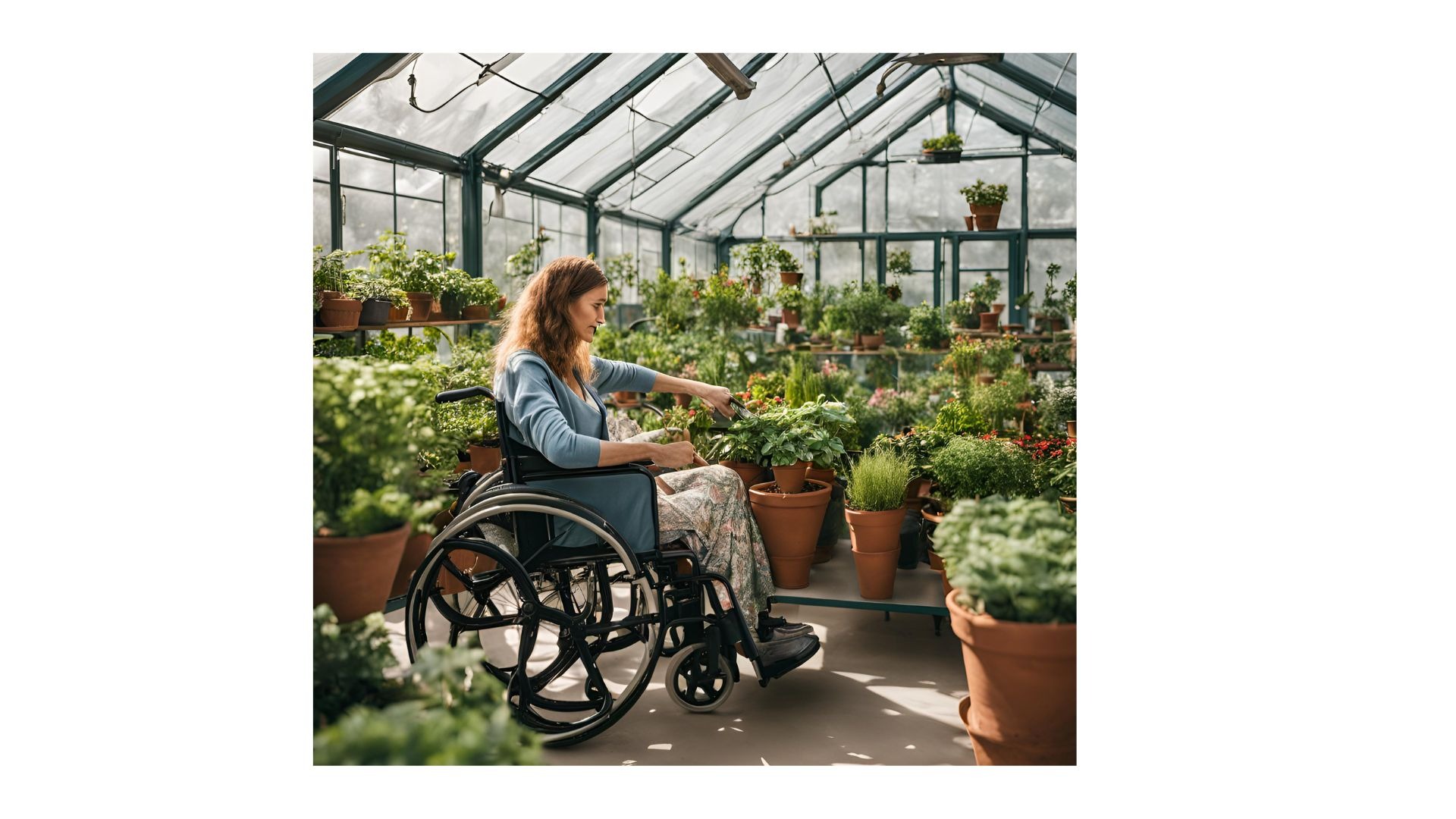
Fresh herbs not only enhance your cooking but can also be used for medicinal home remedies. There’s nothing quite like snipping fresh herbs straight from your own garden. Whether you have acres of land or just a sunny windowsill, creating a small herb garden is a rewarding experience. With a little planning, it can be accessible and enjoyable for everyone, regardless of mobility challenges.
For me, accessibility has been a major factor in gardening. The rules of my allotment meant I couldn’t modify my plot to accommodate my sudden disability, so I'm starting my herb garden at home from scratch. Its not pretty yet, but I love beautiful things, so it will be. I use crutches to walk, struggle with kneeling, and have grip issues due to Raynaud’s and arthritis. This website, Mother’s Nature, is where I’m documenting the progress of my new home medicinal garden as it takes shape. I want to show that ANYONE can enjoy growing their very own medicine and hopefully make a few friends along the way.
Planning Your Herb Haven
Before grabbing your trowel, consider a few key factors:
1. Choosing the Right Location: Most herbs need at least six hours of sunlight daily. Consider the accessibility of your chosen spot—can you reach it easily? Is there a nearby water source? You may find that lugging water cans back and forth from the kitchen sink becomes an awful lot of work if you use any kind of mobility aids. Your back will thank you for a water hose that is mounted at a height that is comfortable for you.
2. Selecting Your plants and Herbs: choose herbs you’ll actually use!
Popular options include:
Aloe Vera- very easy care and so useful for cuts, abrasions and burns.
Basil – Great for cooking and easy to grow.
Mint – Perfect for teas but can spread aggressively, so best in containers.
Rosemary & Thyme – Hardy, drought-tolerant herbs with culinary and medicinal benefits.
Oregano & Chives – Ideal for seasoning and easy to maintain.
3. Making Your Garden Accessible: Think about how you’ll interact with your plants. Raised beds, vertical gardens, and container gardening can make tending easier for those with mobility challenges. A couple of excellent sources of information and in some cases even funding to build your accessible garden is Thrive - a non profit organisation which helps you to plan your garden and provides courses on health in gardening. Find them here: https://www.thrive.org.uk/ Another great source of information is the RHS (Royal Horticulture Society) the leading garden charity, they have an article specifically for accessible gardening. Find the article here: https://www.rhs.org.uk/advice/health-and-wellbeing/gardening-with-a-disability
Indoor Herb Gardens
If outdoor space is limited, indoor herb gardens are a fantastic option, especially for those with mobility restrictions.
Container Gardening: Use lightweight pots with drainage holes on a sunny windowsill or under grow lights. Self-watering pots can simplify maintenance.
Vertical Gardens: Wall-mounted planters or tiered shelves maximize space and make harvesting easier.
Hydroponics: A soilless method that eliminates heavy lifting and digging. While I haven’t tried hydroponics yet, my brother, who lives in Canada where growing marijuana is legal, has extensive experience. We plan to collaborate on a future article exploring this technique.
I’m fortunate to have space both indoors and outdoors, including room for a greenhouse. My setup will incorporate all three, and I’ll document the process here for readers to follow. Indoors, I already have a collection of medicinal houseplants, including several aloes, which you can see pictured below.
Outdoor Herb Gardens
Even a small outdoor area can become a thriving herb garden. Here are some ways to make it accessible:
1. Raised Beds: Raised beds eliminate the need for bending or kneeling. I had a local joiner build me four 6 foot planters thigh high to me, so that I can comfortably perch on the edge while gardening. They’re also just slightly wider than my arm’s length to minimize reaching. I’ve four of these, two in the front yard and two in the back yard, each in different sun-exposed areas to suit my various plant needs. I have filled the bottom of these with some hard core and old wood, in a bastardised way of hugelkultur gardening. (look it up! - some great videos on youtube about it) I now have to fill them with sand, soil, manure and top with compost. They don't look like much now, but just wait until they're planted up! Pictures below.
2. Container Gardening: Pots are ideal for patios, balconies, or driveways. I’ve started collecting pots to line my footpath, making the garden more accessible, this month I'm going to put the big ones on wheels. Lightweight, wheeled containers allow easy repositioning. I can bend from my waist but not my knees so I certainly can't bend and then lift any weight when standing erect (ish) again; so wheels are an absolute must, to accomodate my disability. I've pictured some of the pots I've collected below. I've collected most of these from previous clients and facebook marketplace, most were free, the rest were very cheap, Im on an almost non-existant budget.
3. Vertical Gardening: I plan to install vertical planters along my fences, along with the hanging ones I already have to maximise space without requiring kneeling. This method will allow me to grow more herbs without compromising accessibility.
Greenhouse Gardening
A greenhouse offers a controlled environment for year-round herb growing.
Accessibility Considerations: Wide doorways and pathways ensure easy access. Keeping plants atop work benches bring your plants within easy reach if your're in a chair. The minimum width of an unobstructed pathway should be 0.90 m. The minimum width of a two-way wheelchair traffic passage is 1.50 m. The preferable width is 1.80 m. The slope of an accessible path should not exceed 1:20.
If you use walking aids, you should ensure you have adequate seating, to rest often whilst you garden. Its the most beautiful place to rest! Also, try to store your tools in a way that you can get to them easily.
Climate Control: Proper ventilation prevents overheating, and heating in winter keeps tropical plants thriving. I'm looking at building a biomass heater under my benches and ventilation is going to be a top window with a very long opening pole, because I'm also short!
Supplemental Lighting: Grow lights help accommodate plants requiring extra sunlight.
Humidity Control: A misting system or even a simple spray bottle used daily, can help recreate the moisture levels needed for exotic herbs.
My proposed greenhouse features a smooth floor, so I don't stumble with my crutches, a seating area for resting, and a setup that balances warmth in winter with ventilation in summer. Of course, at the moment its a small patio area whilst I find a cheap used greenhouse to house over it - alternatively, I will find used windows to re-purpose. I am always cost conscious now that I am unable to continue with my cleaning business, due to disability.
Making Your Garden Accessible
Gardening should be enjoyable, not painful or frustrating. Here are some tools and techniques to make it easier:
Ergonomic Tools: Long-handled, comfortable-grip tools reduce strain on hands and wrists. [Check out these ergonomic gardening tools for plants waist height or higher https://amzn.to/3EoL2R8 or these, with long handles for the plants lower down https://amzn.to/431pios ]
Adaptive Equipment: Tools designed for people with limited mobility can make a big difference. [Here is an out door hand rail for pulling yourself up from seats or to go up your steps https://amzn.to/3X1L0F1 and here are some wall mounted hooks to keep your tools easily accessible to you https://amzn.to/430xV2C]
Seating: A comfortable garden bench near your workspace allows for rest breaks. [This is the garden seat I use to move around with. https://amzn.to/3EAAwWP]
Accessible Pathways: Smooth, wide paths accommodate mobility aids.
Companion Planting: Planting complementary herbs together reduces weeding, which can be difficult for those with grip issues.
I’m on a budget, so I’ve opted for affordable yet functional tools and equipment. I only invest in what’s necessary to keep gardening enjoyable and accessible; but they are an investment for this way of life.
Tips for a Thriving Herb Garden
Start Small: Begin with a few herbs and expand as you gain confidence. But keep future addons in mind. Its very difficult to move a raised bed full of soil, or a large tree pot, also full of soil, if you haven't considered your space and abilities very carefully.
Water Wisely: Herbs need consistent moisture but don’t overwater—check soil moisture first and make sure you have well drained soil.
Fertilize Regularly: Use a balanced fertilizer to keep plants healthy.
Manage Pests: Keep an eye out for pests and address any issues early.
Harvest Frequently: Regular harvesting encourages new growth and keeps your herbs productive.
Final Thoughts:
Creating an accessible herb garden is a rewarding way to connect with nature while ensuring fresh, flavorful herbs are always within reach. With thoughtful planning and a few adjustments, gardening can be made enjoyable for everyone, regardless of mobility challenges.
I’ll be documenting my progress on Mother’s Nature, so stay tuned! Have any tips or experiences with accessible gardening? Share them in the comments—I’d love to hear from you! 😊
Creating an Accessible
Herb Garden


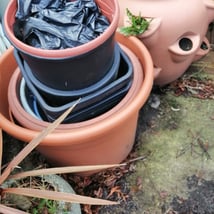
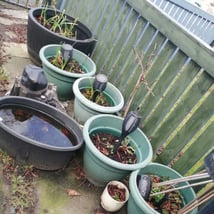
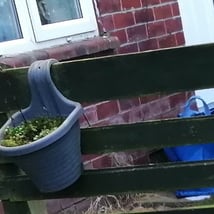
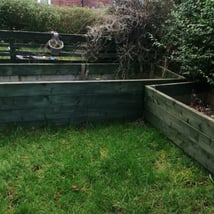
Two of my raised beds and various plant pots waiting to be planted up this year

Creating an Accessible Herb Garden: From Seed to Stomach
Designing small garden spaces to accommodate disabilities
ACCESSIBILITY
